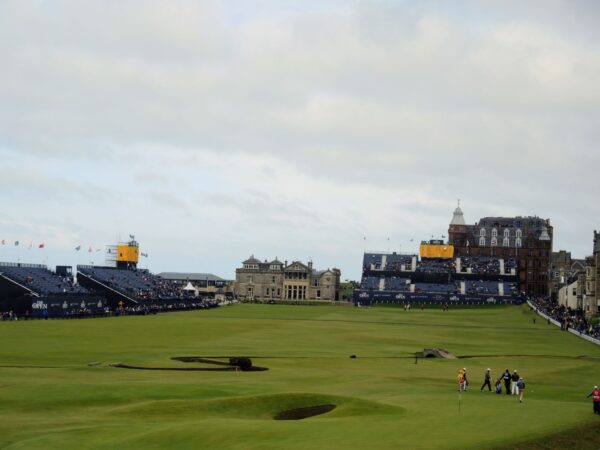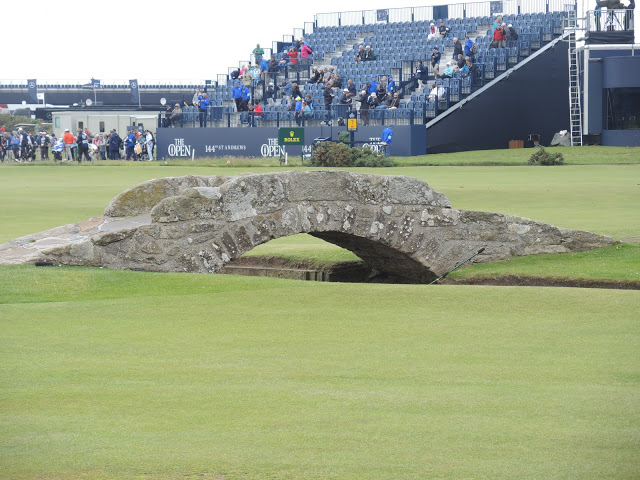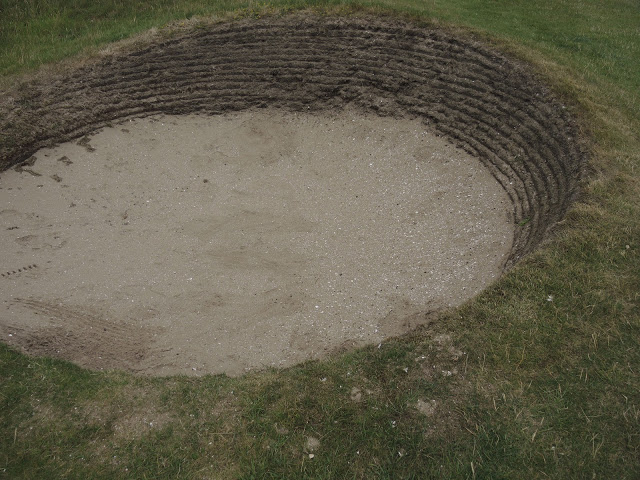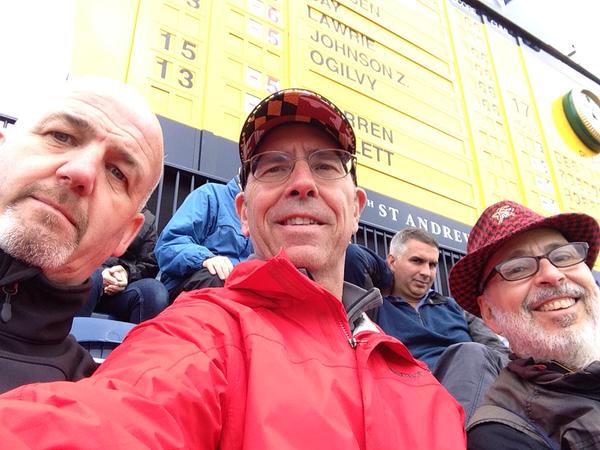About the golf.
At the close of the previous shortened post, we’d just arrived at the grandstand for the fourth hole and our timing was, as the saying goes, fortuitous. Although we’d just missed the threesome that included Lee Westwood and Sergio Garcia, we were only one away from Game 17 – Jordan Spieth, Hideki Matsuyama, and Dustin Johnson. The next group included 1999 Open Champion Paul Lawrie and the third approaching group consisted of Jason Day, Louis Oosthuizen, and Tiger Woods.
Two of the players we saw in the first group missed makeable 15-foot putts – one for birdie and one for par – setting the tone for the day. Of the five games we watched come across the fourth green, we saw only one birdie. That came from the putter of Jason Day and was more a result of his second shot that had left him inside eight feet rather than from a roar inducing putt.
One last note: The double greens create an atypical, rather fractured rhythm of play. A player on one green will wait until a player on the opposite green has putted. By observation, it seemed that the honor was given to the player on the incoming green. Thus, the player putting on four will wait until his counterpart on 14 has taken his putt.
The fifth hole is one of two par fives on the Old Course so we saw the tee shots from each of the threesomes we watched before making our way around the hook of the course to watch some of the play on the two par threes – the eighth and eleventh and to try to find one of the rather widely spaced bathrooms.
Now, you’ll have to permit me my grumpy old man rant. The facilities and services were, sadly disappointing. On the seaside of the course there were bathroom facilities at holes two and ten and that’s a long walk. (Of course, when the walk sometimes looks like this,

it can make hiking a bit more tolerable.)
Still, the food services weren’t much better. Both types of facilities created long lines and, as Tony said, “I came to watch golf not stand in a queue.” And, when one of the food service areas ran out of hot water making tea and coffee unavailable, well, that made the consumption part of the day even more frustrating. Fortunately, Tony had come prepared with toffee and other candy as well as bottles of water that he shared generously and that provided enough sustenance to allow us to make only one meal stop.
Collectively, the three of us thought the galleries’ comfort would have been better served by smaller but more numerous stations posted around the course. The other uncomfortable aspect of the day was one over which even the hallowed R & A had no control – the wind off the North Sea.
If lesson number one was to attend the practice round, lesson number two was: You can’t over dress for Saint Andrews. And don’t let morning sunshine fool you into thinking you can. Yes, there were a few moments when the sun shone and the wind calmed enough to tease us with the promise of comfort. But they were brief and occasional. Generally, with the temperature hovering in the mid to high teens (55-62 for you States siders) and a seemingly relentless wind that gashes through to your bones, you are glad for the layers you’re wearing and still you can find parts of the day chill inducing even if they’re not involved with the play.
Of course, the players face the same conditions relative to comfort and they have to manage their play through it. Thursday, the wind was gentler early and much of the front nine played downwind or had a helpful cross wind. This was the time for most players to post scores. Once they made the turn, and even more so as morning turned to afternoon, the challenge of a course that looks so wide open and superficially simple becomes readily apparent.
Wind and sometimes rain aren’t the only defenses the Old Course tosses at the competitors. There are also the famous (or infamous) pot bunkers – 112 of them. These are quite different from the sand traps on a typical American course. The front of these bunkers is a wall of layered sod where each layer is set an inch or two back from the one beneath it. On our way toward the eighth hole, Bob, Tony and I walked along one of the other courses on the property and got up close and personal with a few of them. Here’s one.
From time to time in other tournaments, you may see players hook a drive onto a fairway adjacent to the one they are playing and generally, that’s not something they want to do. However, one of the other quirks of the Old Course is that sometimes, you need to deliberately play to a different fairway. The famous Road Hole at 17 is a perfect example of this. I don’t know whether players would try to clear the sheds of the hotel under different wind conditions, but on this Thursday, nearly everyone hit their drive onto the fairway for the second hole because no one was going to clear the shed in the face of that wind.
The 18th, home to Swilcan Bridge,
 and which seems to be one of the more “birdie-able” on the course presents a different demand on a player’s skill. The safer play is to hit the drive onto the fairway for the first hole but this makes for a delicate short iron or chip. The more direct route, if the golfer manages to find the right lie, presents an easier second shot onto the green. However, it dares you to play from the deeply undulating swale known as “The Valley of Sin” making that right lie a challenge to find.
and which seems to be one of the more “birdie-able” on the course presents a different demand on a player’s skill. The safer play is to hit the drive onto the fairway for the first hole but this makes for a delicate short iron or chip. The more direct route, if the golfer manages to find the right lie, presents an easier second shot onto the green. However, it dares you to play from the deeply undulating swale known as “The Valley of Sin” making that right lie a challenge to find.
We finished our day in the grandstand high above the eighteenth green. The lower tier is reserved seating. It was there that we finally saw some impressive putting and saw four or five birdies. My and Bob’s Twitter followers might recognize this picture:.
Upon arriving back at Waverly Station, Tony’s wife was waiting for him and Bob and Tony offered me a ride back into the Old City. I had them drop me at Grassmarket where, because it was late and I was tired, I ended up picking up a couple of slices of pizza for dinner. I was most grateful for the lift up the hill from the station which must be among the steepest traversable spots in Edinburgh.
Oh, and the truth I learned about cameras and photography (but not until late in the day when we stood behind the tee box at 13 in a spot as close to the players as we found on the course) is that if you discreetly take pictures at times when it’s clear no one is playing, the marshals are quite lenient and there’s little chance of having your camera confiscated. So here’s where you can see the other dozen or so of the pictures I shot.
And that wraps up my day at Saint Andrews. I hope you enjoyed reading about it. Next, my last day in Scotland and arrival in Copenhagen. Stay tuned.

